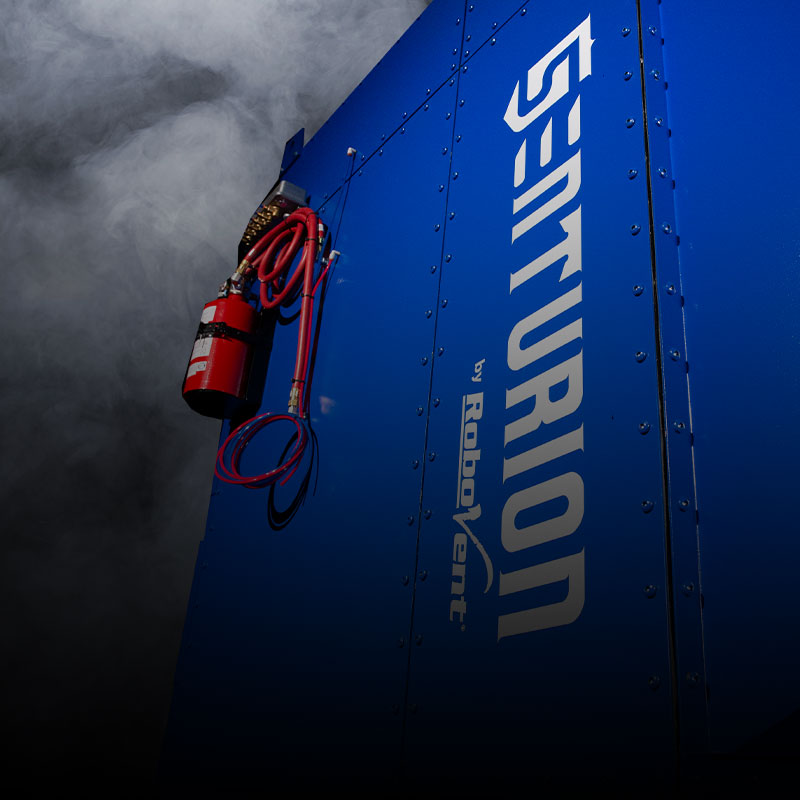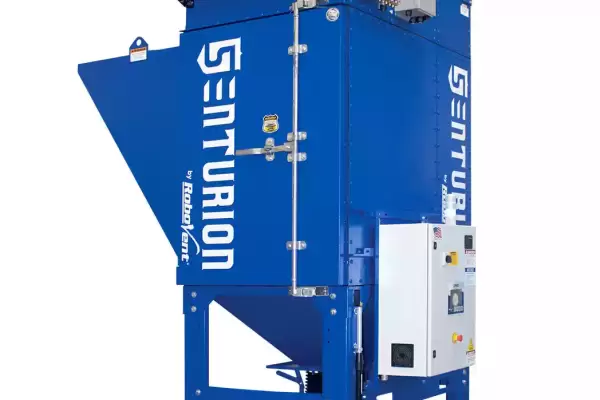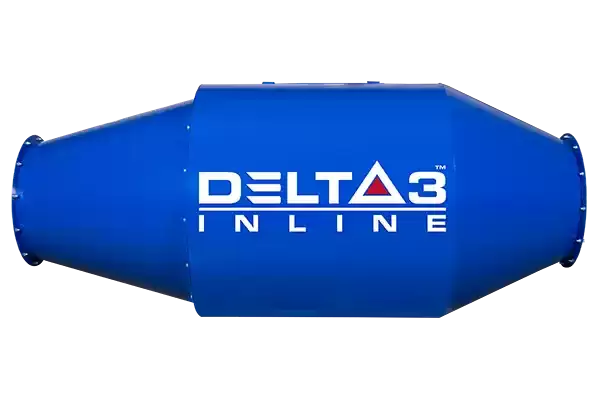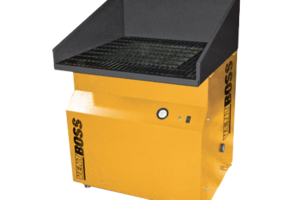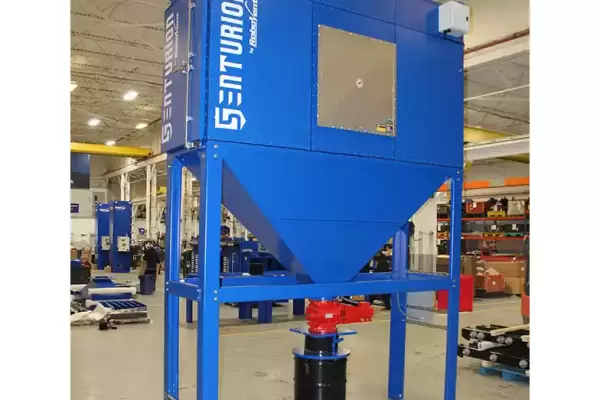PLASMA VS. LASER CUTTING
Laser and plasma cutting are both popular high-speed cutting methods used in the metalworking industry. These cutting technologies tend to produce large dust volumes due to their high speed and high temperatures, which vaporize metals in the cut (kerf).
- Plasma cutting involves an electrically conductive gas to cut through conductive metals, suitable for both CNC and manual operations. This method produces a greater volume of larger dust particles and fumes than laser cutting.
- Laser cutting utilizes high-power laser beams, often directed by CNC machines, to achieve precision cuts on metals. The process generates fine metallic dust and fumes, with particles typically being smaller than those from plasma cutting.
Learn more about dust collection solutions for plasma cutting and laser cutting.
DUST CONTROL SOLUTIONS FOR OEMS AND INTEGRATORS
Need an integrated solution for laser or plasma cutting machinery? We work with original equipment manufacturers (OEMs) and integrators to seamlessly incorporate dust control with production machinery and manufacturing cells.
DUST CONTROL SOLUTIONS: MANUAL VS. AUTOMATED METAL CUTTING
Metal cutting can be either manual or automated. Different dust control solutions are used for manual vs. automated or robotic metal cutting. The right dust control solution depends on the volume and characteristics of the dust and the exposure risks of the process.
- Manual metal cutting is often used for applications such as prototyping, artisanal work, small-batch production, maintenance and repair operations, and job shops where customization and one-off jobs are common. Common manual cutting methods include shearing, sawing, manual plasma cutting, and oxyfuel cutting (torch cutting). Manual metal cutting puts operators at risk of exposure to hazardous metal dusts, so proper dust control is vitally important. Manual cutting dust may be controlled using a downdraft table, fume extraction arm, or backdraft table, depending on the dust characteristics.
- Automated metal cutting is more common for high-production industrial environments requiring high throughputs and a high degree of precision. Computer Numerical Control (CNC) machines are widely used for metal cutting (plasma or laser) due to their ability to produce complex geometries with precision, speed and repeatability that would be impossible with manual machining. CNC machines are often self-contained, with the laser or plasma cutter fully enclosed. The machine must be equipped with an integrated dust collection system or ducted to an external dust collector. Other types of CNCs and metal cutting robots may require a separate hood or enclosure, such as the Streamline Hood.
METAL CUTTING WITH METALWORKING FLUIDS (MWFS)
Metalworking fluids (MWFs) are used in some metal cutting applications to lubricate, cool, and remove metal chips from the cutting zone. While more common in metalworking operations like drilling, milling, grinding, and turning, MWFs may be used for metal cutting processes such as sawing or broaching. When working with metalworking fluids for cutting or machining, oil mist collectors are usually required to capture and remove the fine aerosolized droplets of the fluid from the air.
METAL CUTTING DUST HAZARDS
Uncontrolled metal dust in a workplace or industrial setting can lead to a multitude of problems, ranging from health concerns to operational and safety issues. Some of the key problems associated with uncontrolled metal cutting dust include the following.
- Health Risks: Inhalation of fine metal dust can lead to respiratory problems such as lung irritation, occupational asthma, and long-term diseases like pneumoconiosis. Fine dust and fumes from high-speed or thermal cutting processes are more problematic than coarser dust, as submicron particles can be inhaled more deeply into the lungs. Beyond respiratory issues, certain metals, such as lead, cadmium, or chromium-containing metals (e.g., stainless steel), are inherently toxic and associated with a variety of health issues, including metal fume fever, cancer, and neurological or reproductive and developmental effects. Moreover, skin contact with particular metal dusts can result in irritation, allergies, or even chemical burns.
- Equipment Damage: Metal dust poses a considerable threat to machinery. It can lead to accelerated abrasion and wear of machinery components, reducing their functional lifespan. The conductive nature of metal dust also presents a risk, as it can cause short circuits in electrical equipment. Moreover, an accumulation of such dust can result in clogging of filters, vents, and other essential components, which hampers equipment efficiency. Equipment wear and damage is a particular concern in laser and plasma cutting, as dust accumulating inside an enclosed CNC machine may damage optical sensors, distort the laser or plasma arc, or cause accelerated wear on moving parts such as the gantry or rails. Dust settling on machine components or electronics may also lead to overheating.
- Combustibility and Fire Hazards: Some metal dusts, such as aluminum or magnesium, can be highly combustible when allowed to form clouds in finely divided form. This risk is further exacerbated when one considers that hot metal dust, a byproduct of procedures like grinding or welding, can act as an ignition source, potentially igniting other flammable materials in the vicinity. Learn more about combustible dust hazards.
REGULATIONS FOR METALWORKING AND METAL CUTTING
Regulations regarding metal cutting dust typically aim to ensure worker safety, maintain environmental standards, and reduce fire and explosion risks. The specific regulations that employers should be aware of can vary by country and region. In the U.S., fabrication shops and other employers engaged in metalworking should be aware of and follow:
- Occupational Safety and Health Administration (OSHA): OSHA sets permissible exposure limits (PELs) for many metals and metal compounds found in metal cutting dust. These limits are designed to protect workers from the harmful effects of inhaling or coming into contact with these substances. Employers are responsible for implementing engineering controls, such as industrial dust collection and air filtration, to protect workers from exposure to toxic or hazardous metal dust. PPE (e.g., respirators) should be used in cases where it is not possible to meet the PEL through engineering controls alone, but it should not be considered the first or only line of defense.
- National Fire Protection Association (NFPA): When collecting combustible metal dusts, manufacturers must also follow guidelines and standards set by NFPA for safe material handling and dust collection system design. NFPA 484, Standard for Combustible Metals, provides guidance on the prevention of fires and explosions in facilities that process combustible metal dust. Manufacturers must also follow NFPA 652, Standard on the Fundamentals of Combustible Dust, and NFPA 654, Standard for the Prevention of Fire and Dust Explosions from the Manufacturing, Processing and Handling of Combustible Particulate Solids. (Note: these standards will be replaced by the new NFPA 660 in October 2024.)
CONSIDERATIONS IN DUST COLLECTION SYSTEM DESIGN FOR METAL CUTTING
Designing a dust collection system for metal cutting dust requires a comprehensive approach, considering several factors to ensure efficiency, safety, and compliance. The solution must be tailored to the specific application and process, with consideration of dust characteristics and volumes, human exposure risks, process demands, and facility constraints. Dust collection system design for metal cutting must consider several factors.
- Capture Method: CNC cutting machines are often already enclosed; in this case, the machine should be integrated with or ducted to a suitable dust collector. Other processes will require a hood or enclosure to contain dust and fumes and enable efficient capture. Manual processes require a capture method that will keep dust out of the operator’s breathing zone, such as a downdraft table, fume extraction arm or backdraft hood.
- Dust Collector Selection and Sizing: High-speed metal cutting can produce very large volumes of dust. A cartridge-style dust collector is the best choice for most metal cutting applications, including plasma and laser cutting. It is essential to size the dust collector appropriately for the applications in terms of both airflow (CFM) and filter media area (air-to-cloth ratio). A large centralized dust collector can be ducted to multiple CNC machines or grinding stations.
- Capture Velocity: The velocity at which air is drawn into the collection hood must be high enough to capture and transport the dust particles but not so high as to be wasteful in terms of energy use. Heavier dust particles from sawing or grinding processes will require higher capture velocities than light, fumed particles from thermal cutting.
- Spark Control: Many metal cutting processes, including plasma and laser cutting, produce large numbers of hot sparks. These sparks must be kept out of ductwork and the dust collector filter chamber. A spark arrestance system, such as a metal mesh spark trap or centrifugal spark arrestor, should be integrated with the dust collector intake or ductwork.
- Filter Efficiency and Cleanability: Filters should be efficient enough to capture the finest particles produced. For fumed particles created by thermal processes such as laser or plasma cutting, that usually means an air cartridge filter with a filtration efficiency of MERV 15 or higher. Additionally, given the volume of dust in metal cutting, filter cleaning mechanisms, such as pulse-jet systems, can help maintain filter life and system efficiency.
- Fire and Explosion Safety: Some metal dusts, especially aluminum and titanium, can be explosive under certain conditions. The dust collection system might need a deflagration system including explosion vents, isolation valves or other safety features.
TALK TO THE METAL CUTTING DUST CONTROL EXPERTS
At RoboVent, we are the experts in dust collection for metalworking, fabrication and other manufacturing processes. We can help you:
- Evaluate your air quality and exposure risks.
- Design and engineer a dust and fume extraction solution tailored to your metal cutting application.
- Ensure compliance with all applicable regulations for dust and emission control.
RECOMMENDED SOLUTIONS
OTHER SOLUTIONS
TOTAL FILTRATION PARTNER
RoboVent is your full turnkey resource for clean air in industrial environments. From facility testing and engineering, to installing equipment, providing replacement filters and preventive maintenance, RoboVent is ready to manage the whole process.
CONTACT US
Contact one of our industrial dust experts to gain the advantage against dust-generating processes and applications.


